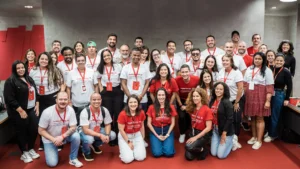There are companies that claim to be sustainable when, in fact, they are not. This type of practice is called greenwashing, or “green makeup”, an attempt to camouflage its real impact on the environment by carrying out false positive advertising.
Therefore, understand what greenwashing is, its examples and tips for recognizing false advertising.
What is greenwashing?
Firstly, greenwashing was the name created by environmentalist and researcher Jay Westervel, from the United States, in 1986, and is still used today. At the time, he used the word to talk about a resort in Samoa that was boasting about using a reusable towel service to reduce environmental impact when, in fact, it was devastating the area to expand its facilities.
Where and when did the term greenwashing appear?
Thus, at the same time, the oil company Chevron was running a million-dollar advertising campaign on television to show that it protected the environment, on which it spent more money than on its own conservation projects.
For these and other reasons, we will consider this case the “gold standard”, that is, a reference when talking about greenwashing.
Why do companies greenwash?
In many cases, the main motivation is the search for profits and reputation. There is a growing consumer demand for sustainable companies.
Furthermore, pressure from interest groups and regulatory bodies leads some organizations to adopt deceptive strategies to capitalize on this trend and gain a competitive advantage.
Greenwashing allows these companies to position themselves as leaders in sustainability, without necessarily changing their internal practices.
Furthermore, another factor that makes companies put greenwashing into practice is the lack of adequate regulation in the field of environmental responsibility.
Therefore, without clear rules and penalties for deceptive practices, some companies see an opportunity to obtain financial benefits. Finally, companies also do not want to make the real commitments necessary for real sustainability.
Greenwashing: examples
As in these examples, the word greenwashing when a company launches advertising campaigns about operations or products that are supposedly sustainable.
In this way, all of this is done to win the hearts of consumers, who are increasingly looking at conscious brands, and differentiate themselves from the competition.
Thus, in 2021, the European Commission researched, for the first time, the greenwashing in its website tracking to identify illegalities regarding Consumer Law. Experts evaluated several sectors, such as cosmetics and clothing, to check the veracity of advertisements from companies that claim to be sustainable.
Result: In 42% of cases, advertising that a product was sustainable was exaggerated, false or misleading. O report concludes that the greenwashing is growing as consumers become interested in making “greener” purchases.
Furthermore, in more than half of the cases, companies did not provide enough information for the public to judge the veracity of what was written in the description of their products or services.
Thus, in 2019, the Brazilian Institute for Consumer Protection (Idec) researched 509 products in supermarkets that claimed to have socio-environmental benefits and found the greenwashing in almost half of them (48%).
Deodorants, garbage bags and shampoos, for example, were the champions of false advertising. Idec reinforces that claims such as “environmentally friendly”, “Earth friendly” and “ecological” are prohibited by the Defense Code of
Consumer, as they do not express information clearly and adequately and can lead the consumer into error.
How to recognize greenwashing
According to the agency TerraChoice, the main clues to greenwashing are:
- Lack of evidence about the environmental appeal, such as certification;
- Use of vague and imprecise terms, such as “natural”;
- Irrelevance of the claim, such as saying that a product does not contain CFCs when none does, as it is prohibited by law;
- Misleading label, which uses false words and images to give the impression of being “green”.
Ethical Consumer magazine gives some tips to find out if a company is doing greenwashing. Before buying something, you need to stop and ask these 4 questions:
Is the company's operation very or little sustainable?
If only a minimal part of the company's activities is sustainable (and most of it causes great environmental damage), it is quite possible that that beautiful, nature-filled campaign will be greenwashing.
What does this company consider sustainable?
Does what she thinks is sustainable give match with your point of view – and that of the experts? If the company says it has renewable energy sources but continues to invest in coal and oil, the answer is “no” (look at the greenwashing).
How does this company compare to others in the same industry?
Researching what the competition does helps you know which companies are really investing in sustainability and which are just trying to take advantage of advertising.
Where does this company invest?
If the company puts its money into unsustainable practices, there is a good chance it is running campaigns to distract consumers while it continues to exploit the environment.
According to the magazine, the more we are aware of the greenwashing, the more we can question companies and demand more transparency regarding sustainability.
iFood initiatives
Do you want to know some of iFood's sustainability initiatives? We list some of them here:
iFood Regenerates
It is the pillar of iFood that encompasses a positive environmental impact plan with two major goals to be met by 2025: end plastic pollution from delivery operations and make the company neutral in greenhouse gas emissions greenhouse effect with initiatives such as investment in electric vehicles and research into sustainable packaging.
Neutral 100% Deliveries
Since July 2021, 100% of CO2 emissions were neutralized of deliveries made by iFood. In addition to reducing the environmental impact of delivery, the initiative will also generate resources that will be invested in preserving the Amazon Forest.
Reducing single-use plastic
iFood signed a public commitment in 2021 to reduce single-use plastics in its food deliveries with the #DeLivreDePlástico campaign, organized by the United Nations Environment Program (UNEP), the main environmental authority in the United Nations (UN) system, and by Oceana, the largest non-governmental non-profit organization focused on in protecting the world's oceans.
More sustainable packaging
Finally, in 2021, iFood tripled its sustainable packaging suppliers, made with materials such as sugar cane, cassava, paper and corn starch. One of these partners, “Já Fui Mandioca”, uses cassava starch to produce sustainable biopackaging, which becomes fertilizer in up to 90 days.
5 tips on how to avoid greenwashing
Check out some tips to avoid companies that practice greenwashing:
- Conduct thorough research into the company’s sustainability practices
- Analyze the evidence and information provided by the company about its sustainable initiatives
- Verify that the company's actions are consistent with its sustainability claims
- Pay attention to recognized sustainability seals and certifications
- Assess the company’s commitment to transparency and environmental accountability


